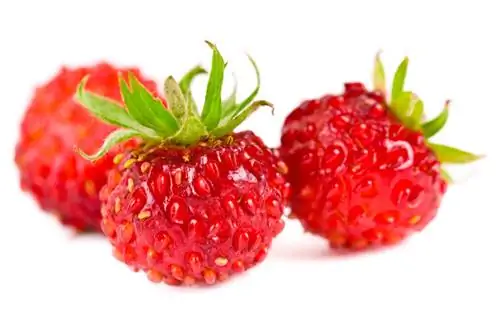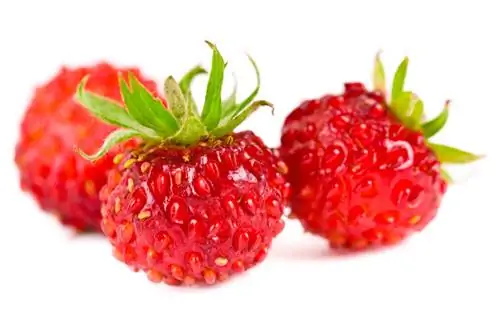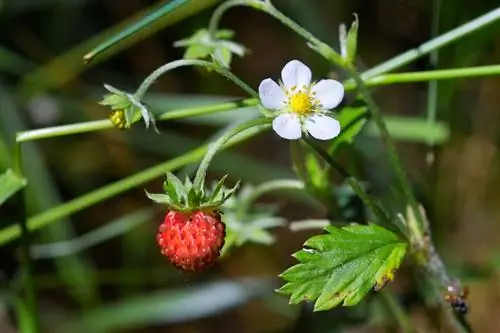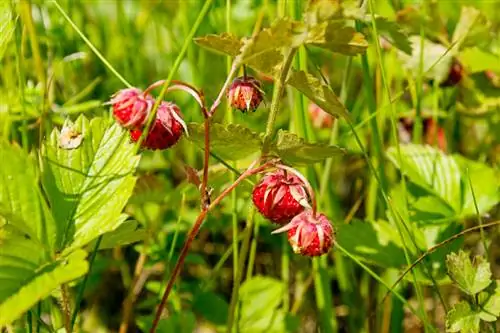- Author admin [email protected].
- Public 2023-12-16 16:46.
- Last modified 2025-01-23 11:20.
Wild strawberries differ considerably from typical cultivated strawberries in terms of origin and cultivation. Hobby gardeners can find out here how to master cultivation, planting and care competently.

How do I grow wild strawberries in my own garden?
For cultivation, wild strawberries require peat sand or coconut fiber as a substrate, a cover at 18-20°C and regular watering in late February to mid-March. After germination, they are transplanted into individual pots. They thrive in sunny to partially shaded locations and in humus, moist, nutrient-rich soil.
Growing behind glass
If you no longer want to look for wild strawberries along forest edges and in clearings, plant the delicious fruits in your own garden or on the balcony. The best time for sowing begins at the end of February and extends until mid-March. How to manage cultivation indoors:
- Soak the seeds in water for 4-6 hours
- Pour peat sand, coconut fibers or commercially available sowing soil into a seed tray
- scatter the seeds, sift them thinly and moisten with water from the spray bottle
- cover with foil or place in the indoor greenhouse at 18-20 degrees Celsius
The cotyledons appear within 3 weeks. The cover is now ventilated more frequently until it falls away completely. The location should now be bright, but not full sun, and a little cooler so that the seedlings do not rot. The younglings with 3-4 leaves are transplanted into individual pots, where they are to be kept constantly moist until planting out.
Select location and prepare carefully
In contrast to sensitive cultivated strawberries, wild strawberries offer more flexibility when it comes to choosing a location. As the robust plants in the wild prove, they thrive even under less optimal lighting conditions. The local strawberries reach their optimum under the following conditions:
- sunny to semi-shady locations
- problem-free growth also as underplanting for shrubs and trees
- nutrient-rich, humus-rich, fresh, moist soil
- In the flower box or bucket, commercially available compost-based potting soil serves as a substrate
So that the young plants you have grown yourself or purchased ready-made take root, the soil is deeply loosened. Weeds, roots and stones must be completely removed. Ideally, you should clean the excavation with a sieve. Then enrich the soil with compost, stable manure, horse manure or a special berry fertilizer.
When is planting time for wild strawberries?
You can choose between two planting dates, each with individual advantages. Wild strawberries planted in July produce the first fruits in May next year. Young plants planted in March or April produce their first crop of fruit in the same year under good weather conditions.
Instructions for professional planting
Give the prepared soil a few days to settle. Then you can start planting without having to intensively work on the clod again.
- Put the potted young plant in water for 30 minutes
- In the meantime, dig holes with twice the volume of the root ball
- A planting distance of 20 centimeters is considered sufficient, or 25 plants per square meter
- Unpot the soaked plants, place them in the ground and water generously
- the heart bud must be above the surface
In the pot or balcony box, first create drainage over the floor openings to prevent waterlogging from forming. Suitable inorganic material are crushed pottery shards, pebbles, grit or perlite. Then fill the substrate halfway, make a depression in it and plant the wild strawberries.
Proper care right from the start
If the planting in the garden and on the balcony was successful, your wild strawberries will present an enchanting white blossom in May. In order for the growth process to result in the longed-for harvest of sugar-sweet fruits, the following aspects of care are important:
- water regularly, allowing the substrate to dry
- fertilize with compost or liquid fertilizer before flowering
- break out the first flowers after planting to increase crop yield
- mulch with straw or bark mulch from the start of fruit formation
If you have done everything right, you will harvest countless small red strawberries with a wonderful aroma throughout the summer until the first frost. Please remember that wild strawberries do not ripen either. Only pick fruits that are completely colored. Specimens with a green-white border will not be harvested.
How to prepare wild strawberries for winter
Wild strawberries are hardy and can therefore be easily cultivated for several years. To ensure that the plants thrive just as diligently in the next season, they receive another round of care after the harvest. Before the buds are laid for the following year in autumn, cut the plants back. The heart bud is not affected by this measure.
Following pruning, wild strawberries receive further fertilization with compost or an alternative organic or mineral preparation. Winter protection is not necessary in the bed. The specimens in the planter are placed on a wooden block in front of the house wall. Covered with bubble wrap or garden fleece, the root area is protected from freezing.
Tips & Tricks
The wild strawberry diligently spreads a variety of runners. If you curb this urge to spread by cutting back, the delicate leaves are far too good to be disposed of in the compost. When brewed with boiling water, they produce an invigorating and highly aromatic tea.






